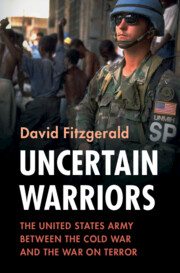Book contents
- Uncertain Warriors
- Military, War, and Society in Modern American History
- Uncertain Warriors
- Copyright page
- Dedication
- Contents
- Figures
- Acknowledgements
- Introduction
- 1 The Post-Vietnam Recovery, Operation Desert Storm and the Veneration of the Volunteer Soldier
- 2 Gender, Sexuality and the Profession of Arms
- 3 Warriors Who Don’t Fight
- 4 Downsizing, Recruiting and Debates over Military Service
- 5 Technological Transformation and the American Soldier
- 6 The Warrior Ethos
- Epilogue
- Index
Introduction
Warriors at the End of History
Published online by Cambridge University Press: 19 October 2023
- Uncertain Warriors
- Military, War, and Society in Modern American History
- Uncertain Warriors
- Copyright page
- Dedication
- Contents
- Figures
- Acknowledgements
- Introduction
- 1 The Post-Vietnam Recovery, Operation Desert Storm and the Veneration of the Volunteer Soldier
- 2 Gender, Sexuality and the Profession of Arms
- 3 Warriors Who Don’t Fight
- 4 Downsizing, Recruiting and Debates over Military Service
- 5 Technological Transformation and the American Soldier
- 6 The Warrior Ethos
- Epilogue
- Index
Summary
The Introduction sketches out the key themes of the book, offers a justification for focusing on the identity of the American soldier as a key issue in the Army’s post–Cold War transformation and introduces the reader to literature on ‘warrior culture’. Just as Army leaders and ordinary soldiers often meant very different things when they spoke about warriors, so contemporary historians, anthropologists and classicists have used the term in various ways. Thus, the latter part of the Introduction spends some time examining how the term has evolved and been deployed in different contexts.
Keywords
- Type
- Chapter
- Information
- Uncertain WarriorsThe United States Army between the Cold War and the War on Terror, pp. 1 - 17Publisher: Cambridge University PressPrint publication year: 2023

